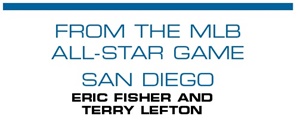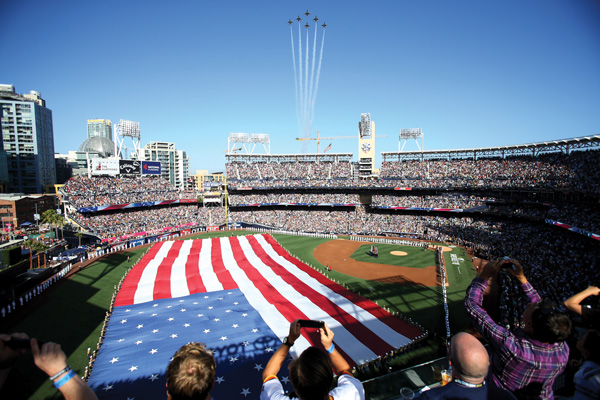 |
A giant flag and a military flyover were part of the All-Star Game pregame at Petco Park.
Photo by: GETTY IMAGES
|
Perhaps more than ever, the MLB All-Star Game was a story in two parts.
Locally, San Diego and the host Padres, as well as Petco Park, received rave reviews from visiting sponsors and executives. MLB Commissioner Rob Manfred beamed about the Southern California locale, calling it an “absolutely phenomenal” site for the All-Star Game, citing the city’s famously great weather and the tight, walkable footprint of the ballpark, area hotels and convention center.
MLB blew away event records for on-site merchandise sales, with the brown-and-gold batting practice jerseys patterned after the Padres’ original color scheme particularly popular. The league successfully incorporated several new outdoor events, including an expanded concert series and new yoga event, into the run of activities.
The rest of the country, however, showed unprecedented indifference this year to baseball’s Midsummer Classic. The All-Star Game itself hit a new low with a viewership of 8.71 million people, the first time it failed to draw at least 10 million, and it also failed to win the night in prime-time competition. Ratings for the Home Run Derby fell by 22 percent from 2015, and barely beat out a record low figure from the rain-delayed event two years ago in Minneapolis.
Secondary ticket pricing, which is fueled in part by out-of-town visitors, also showed double-digit percentage declines from last year’s All-Star Game events in Cincinnati. Even fan voting for the All-Star Game was down markedly, though that was largely the byproduct of new rules that created a new daily limit of five votes per person.
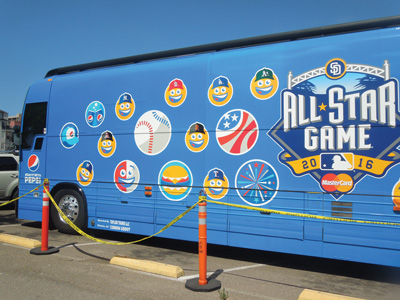 |
The emojis that are part of sponsor Pepsi’s campaign arrived in San Diego on a bus.
Photo by: TERRY LEFTON / STAFF
|
The overall trend is several years in the making. At the local and regional level, baseball remains healthy and vibrant, with regional sports networks ratings and home attendance for most teams tracking at historically high levels. The slide in several national figures, conversely, suggests many fans care deeply about their own teams and less so about baseball broadly.
The declining TV figures are blunted in part by consumption of digital baseball products such as the MLB.com At Bat mobile application. But Tony Clark, MLB Players Association executive director, conceded that other sports have done a better job turning many of their stars into household national names.
“Unfortunately, as an industry, we’ve done well regionally with respect to promotion of our players, but the other leagues nationally move their players out into the forefront,” Clark said. “I think what you’ve seen over the last 10, 12, 15, 20 years is a shift of engagement with our young people and with businesses that have latched onto NBA guys, NFL guys as a result of the marketing and promotion that are done in those particular industries.”
■
YOU SPIN ME ROUND: The All-Star Game marked the first national-level baseball use of Replay Technologies, which provides 360-degree panoramic replays.
After several years of local use in venues such as Yankee Stadium and Dodger Stadium, football efforts such as in “Sunday Night Football” and deployment in the NBA playoffs, industry giant Intel bought Israel-based Replay Technologies in March for an estimated $175 million. With the backing and massive resources of Intel, the product is being prepped for a significant expansion.
The high-end replays were produced for both ESPN during the Home Run Derby and Fox Sports during the All-Star Game itself using 28 high-definition cameras positioned around Petco Park, nearly triple the size of a prototype system used at Yankee Stadium three years ago.
With Intel now a league partner, efforts are underway to develop a version of the replays for consumers.
“This is a huge boost for storytelling. Now the question is taking it to another level,” said Preston Phillips, an Intel vice president. “Beyond broadcast, there are a whole array of avenues we could potentially go [down] in terms of on-demand and interactivity, data and analytics for scouting, and so on.”
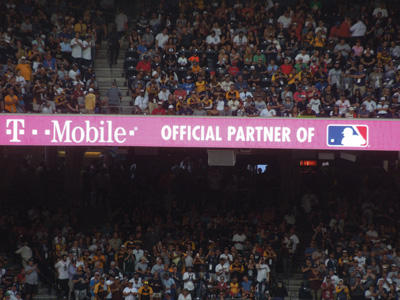 |
T-Mobile was among MLB sponsors getting time on Petco Park’s digital sign boards.
Photo by: TERRY LEFTON / STAFF
|
■ PETCO LAB: MLB Advanced Media’s luxury suite at Petco Park, beyond entertaining guests and sponsors, doubled as an experimental technology showroom as the league’s digital arm showed off an array of emerging products and platforms, including virtual reality, augmented reality, 8K television and a prototype tablet-based version of Intel’s panoramic replays.
Many of the individual projects, as they work their way toward broader rollouts over the next 12 to 18 months, will also be integrated into MLBAM products such as Statcast and MLB.TV, aiding both the consumer and team-level market segments. The suite also showed MLBAM’s restless spirit as it aims to remain on the forefront of emerging digital technology.
“These are all different experiences, but getting in on the ground floor on all of them will allow us to better tailor them to our fans and our teams as they come of age. And they are coming of age quickly,” said Joe Inzerillo, MLB executive vice president and chief technology officer.
The heightened focus on technology could also be seen at FanFest, where several league partners sought to incorporate more interactivity and touch screens into their exhibits. MLBAM itself for the MLB.com booth featured an expanded hands-on area where fans could sample the companies’ mobile applications and games in a Apple Store-like setting.
■ LOCAL SOURCING: In most years, the ballpark concessionaire for the All-Star Game host team pulls out the stops to create an array of new food and beverage choices. That was not the case this year at Petco Park, which has already garnered widespread praise as one of the game’s top destinations for in-venue offerings. As a result, the Padres and concessionaire Delaware North did not radically rework the menu for last week.
Beyond widespread choice, the pair has also largely avoided gimmicky food combinations at Petco Park in favor of a heavy commitment to local food and beverage sourcing. More than 40 beers are sold at the ballpark, many locally brewed and reflecting San Diego’s rising status as one of the country’s top craft beer locales. Several of the ballpark’s top food items, including the Burgundy Pepper Tri-Tip Beef sandwich and Phil’s BBQ ribs, are from popular local establishments outside the park in San Diego. Most of the higher-end options are not limited to the ballpark’s suites and clubs.
“We’re very blessed here that we have a really great area to tap into with a lot of great products and food sources,” said Carlos Vargas, Petco Park executive chef. “What we have seen, both this week and during the regular season, is people coming two hours early, or right when the gates open, to eat and try all that we have instead of going out somewhere else before the game.”
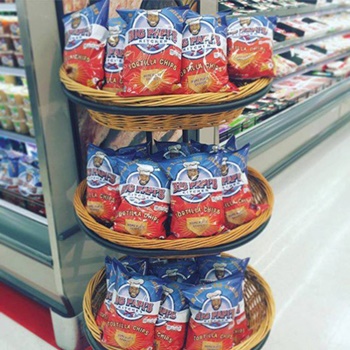 |
Among David Ortiz’s post-baseball plans: Expanding his Big Papi’s Kitchen food brand.
Photo by: TERRY LEFTON / STAFF
|
■ ORTIZ AU REVOIR: Boston designated hitter and American League starter
David Ortiz played a mere three innings in the All-Star Game. On the field, he carried out the AL’s lineup card and received a group hug from teammates and a standing ovation from the crowd after being pulled for a pinch runner. Off the field, Big Papi kept his marketing activities in San Diego to a relative minimum. Still, the final months of his decorated career will see plenty of activation.
Comcast shot an ad for its Xfinity voice-controlled remote service, using both a uniformed and civilian-attired Ortiz and son D’Angelo (also known as Little Papi), in Boston before last week’s game, and during a road series against the Yankees immediately after the All-Star break. Digitas is the creative agency for Comcast. The ad is expected to air in all Comcast cable markets by late August.
Chef’s Cut jerky will also produce an ad with Ortiz in August.
As a tribute to famous baseball movie “Field of Dreams,” ’47 Brand is building an Ortiz tribute in a Massachusetts cornfield. The licensed apparel brand will open a pop-up store outside Fenway Park next month filled with Ortiz products. Dunkin’ Donuts will pay tribute to him with its right field sign at the venerable ballpark.
Alex Radetsky’s New York-based Radegen Sports Management handles marketing for Ortiz.
Post-retirement, Ortiz is starting a production company; mulling broadcasting possibilities from MLB rights holders ESPN, Fox and NESN; and plotting an expansion of his Big Papi’s Kitchen food brand, which now includes chips, salsa and hummus.
■ NAME GAME: We continue to believe that more than half the value of any naming-rights deal is in the “walkup” period, before the venue opens. Still, the next MLB All-Star games will be held in Miami and Washington, D.C., baseball parks without corporate names. Accordingly, we’re curious to see if the spotlight that the ASG shines on the host venue will be the impetus for naming deals, which seem conspicuously absent in those high-profile markets.
Miami’s Marlins Park opened in 2012, and its futuristic styling at a time when most ballparks have embraced retro looks might have been enough to attract attention. But naming rights were still recovering from the recession of 2008-09.
Since earlier this year, Premier Partnerships has been assisting the Marlins in selling naming rights in Miami, where the city’s reputation as a gateway for Central and South America makes companies from those regions likely targets. Sources tell us $5 million to $6 million a year will get a deal done with the Fish, which will include a large stadium signage package.
Another intriguing sales point: The defending champion of the Home Run Derby is Marlin Giancarlo Stanton.
“Prestige events draw attention, but you can’t build a program around only those,” said Jason Miller, senior vice president at Premier and a former Dolphins marketer. “There’s a lot of wealth that’s focused on the [Miami] market, but it’s also one of the best Hispanic markets in America, for any marketer targeting there.”
Nationals Park opened during the 2008-09 recession, with ownership desperate to match the Mets’ impressive deal of $20 million a year for 20 years. It didn’t happen.
After the recession put the naming-rights business on hold, ownership readjusted, but insiders tell us their insistence on $15 million a year will keep a deal from happening there, with or without an All-Star Game.
■ WORLDLY CONCERNS: The sites for the semifinals and finals of the 2017 World Baseball Classic, owned and operated by MLB and the MLB Players Association, have yet to be announced, with a late July disclosure possible. Industry sources said concerns over the Zika virus, which has caused numerous issues with the Rio Olympics, are a contributing factor.
Chris Park, MLB senior vice president of growth, strategy and international, would say only that the tournament sites will be named soon. Regarding Zika fears feeding the announcement delay, he added, “I wouldn’t pin it all on that.”
“There are substantial planning issues for us to get through and we have a lot of interest from different communities that want to participate, which should allow us to do more involved but broader distribution deals. … This is still only our fourth edition, so it’s still very much a startup,” he said.
MP & Silva earlier this year signed a deal to retain global media distribution rights for the 2017 WBC, and added some nonexclusive sponsorship rights to its assets.
■ RIGHTS RENEWAL RAP: Since the regime change at MLB beginning in late 2014, MLB has transformed into more of a media sales company than one where sponsorship rights are paramount. It has also established an enviable record in terms of renewals. For entirely different reasons, two pending re-ups are especially noteworthy: Pepsi and Church & Dwight.
The beverage and salty snacks marketer has been an MLB corporate patron since 1997, so will that relationship, built and maintained by the old MLB, survive? A few factors to consider: Since profits are down, Coke has little tolerance for property rights bidding wars. Additionally, Pepsi is now supporting costly rights deals with both the NBA and NFL, which was not the case when the prior MLB deals were due. Working in Pepsi’s favor: the seasonality of baseball, and the fact that about half of MLB clubs pour its products. It also seems implausible that Pepsi-owned Gatorade would relinquish its MLB rights of long standing; it has been a corporate sponsor since 1990, making it baseball’s oldest.
Church & Dwight, which sponsored the ASG Color Run in San Diego, is in the last year of a three-year deal that made it MLB’s first official laundry detergent and stain remover, and included rights across fabric care, oral care and pet care categories. That renewal is also intriguing, since it offers MLB a way to connect with the audience of moms who buy its Arm & Hammer and OxiClean laundry products and who possess unrivaled consumer purchasing power.
There have also been management changes at C&D since the MLB deal, the company’s largest sports sponsorship ever, was signed in 2014. Former C&D CEO Jim Craigie, a big supporter of the original deal, retired at the end of 2015. It’s also worth noting that C&D has a new chief marketing officer as of January.
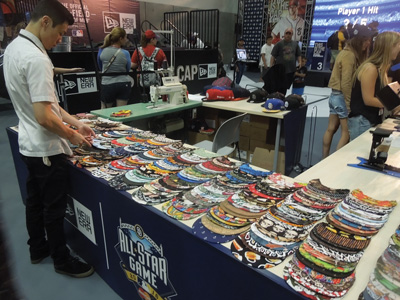 |
Customization (here featuring New Era) helped drive record licensed goods sales at FanFest.
Photo by: TERRY LEFTON / STAFF
|
■ LICENSE TO SELL: Record sales of MLB licensed products were one of the strongest indicators of the event’s continued strength locally.
The league reported that its MLB.com Shop at FanFest broke sales records established by the ’07 FanFest in San Francisco and ’08 in New York City. Sales were up 36 percent from last year’s FanFest shop in Cincinnati.
MLB jersey rights holder Majestic also had its best All-Star Game ever. “Product is better, you’ve got great young players in baseball, the concerts and other events were well-integrated, we had more retail locations and we’re all connecting with fans better, whether it’s with retail activation or social media,” said Jim Pisani, VF Corp. licensed sports group president, whose company had an ASG pop-up store on the USS Midway.
Why the sales bonanza? Others attributed it to the 35,000-square-foot FanFest store, the largest ever, which allowed plenty of space for player appearances, customization of a variety of products, DJs, and artists creating customized takes on licensed products.
Aramark Sports & Entertainment President Carl Mittleman was projecting record sales as early as Monday morning. “We’re giving shoppers a reason to be here and a reason to stay,” he said. Aramark ran MLB’s FanFest store for the 18th consecutive year.
“That kind of ‘retailtainment’ environment just works — this has shown us that,” said Adam Blinderman, MLB vice president of consumer products. “It’s told us that 35,000 square feet is really the magic number, if not larger.” With the Miami Convention Center under construction, it’s uncertain whether that much space will be available for next year’s All-Star Game.
■ NEW JERSEY: While All-Star Game licensing sales broke records, the foremost discussion topic among MLB licensees in San Diego was the impending sale of VF’s Majestic brand, which has held on-field rights for decades.
With MLB looking hard for a footwear brand that will supply additional marketing muscle to its premier licensed product, much of the industry chatter has either Nike, which this year has more than half the MLB All-Stars under contract, or Under Armour getting on-field rights. That would leave Fanatics and Outerstuff vying for rights to produce MLB fanwear. A Nike victory would mean the Eager Beavertons would then have uniform rights to MLB, the NFL, and the NBA, the last of which starts in the 2017-18 season.
“It gets down to priorities,” a senior executive at a longtime MLB licensee said. “Under Armour and Fanatics will pay higher rights fees; Nike will put more behind marketing baseball than any licensee. You tell me which one of those is more important to [MLB] ownership.” Sources told us a sale won’t be completed until September, at the earliest.



